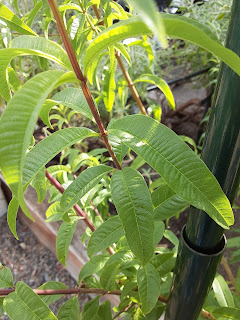 |
| A view of the storm clouds from my front door |
It's unusual for a storm this size and strength to come through this area. Even more unusual for us is to have a thunderstorm also drop so much rain, especially in August. How unusual? I haven't seen a storm like this in my lifetime. The last time we had a storm that even came remotely close, I was a little girl experiencing my first thunderstorm and saw lightning strike the flagpole at the high school near my parents' house. It was an early lesson on the power of Mother Nature. My mom's enthusiasm for stormy weather was in full swing that night, and I think it was contagious. I've been fascinated with thunderstorms ever since.
A gardener quickly learns that she is at the mercy of Mother Nature every day. We have no control over heat waves, dry winters, cold snaps, sudden downpours, or thunderstorms. We plant with care, feed and water our gardens, treat plant diseases as best we can, maybe talk to our plants, and...that's where our control ends. We cannot fight the weather, and we have to take our metaphorical punches if it all goes cattywampus. If Mother Nature is not too unkind, our plants will flourish. And if not......well, you may have to start over.
Right now, I'm worried about some of my veggies, the spaghetti squash in particular. We've been treating the leaves for powdery mildew (a tough plant disease to get rid of if it's allowed to spread too far), and I worry that too much moisture will exacerbate the problem beyond our ability to treat it. We have a few squash very close to harvest, so I'm keeping my fingers crossed that they pull through. Tomatoes, in my experience, are very fussy about getting watered on their leaves (they hate it--always water them at the base of the plant), so I hope ours don't protest the rain too much and still decide to continue producing their lovely fruits for us to enjoy.
We'll go out and check the garden once the storm passes on. For now, I'll sit and catch the flashes of lightning, and listen to the booms of thunder.






















